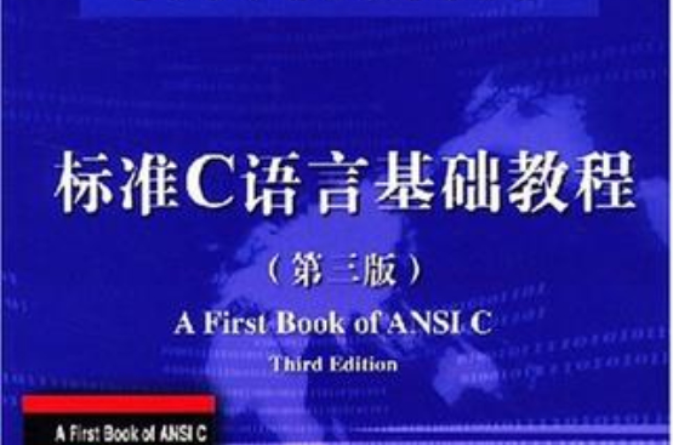《标準C语言基础教程》是2004年电子工业出版社出版的图书,作者是(美)布朗森。本书条块清晰,章节设定合理,适合用做高等学校本科或专科教材,也适合于初学编程的瞬息自学者。
基本介绍
- 书名:标準C语言基础教程
- 作者:[美] 布朗森 着
- 译者:单先余 陈芳 张蓉
- ISBN:7121026597
- 页数:586页
- 定价:20.30
- 出版社:电子工业出版社
- 出版时间:2004-09-01
- 开本:16
作者简介
作者:(美)布朗森 译者:单先余 陈芳 张蓉
内容简介
这是一本介绍C语言编程的经典教科书。作者从不同的角度出发,全面介绍了C编程中涉及到的数据类型、算术运算、逻辑运算、变数、条件语句、函式、数组、指针、字元串、结构、档案操作、位操作、宏、库函式等基本内容,使读者在学习之后就能很快掌握C编程的精髓。本书还专门介绍了C 的一些重要特性,如抽象数据类型、类和类的继承等。本书还介绍了Visual C 6.0和C Builder的使用方法,并且每章都附有大量习题,附录还列出了主要习题的答案。
图书目录
Part 1 Fundamentals
Chapter 1 Getting started
1.1 Introduction to Programming
1.2 Introduction to Modularity
1.3 The printf() Function
1.4 Programming Style
1.5 Top-Down Program Development
1.6 Common Programming Errors
1.7 Chapter Summary
Chapter 2 Data Types, Declarations, and Displays
2.1 Data Types
2.2 Arithmetic Operators
2.3 Displaying Numerical Results
2.4 Variables and Declarations
2.5 Integer Qualifiers
2.6 Common Programming Errors
2.7 Chapter Summary
2.8 Chapter Supplement: Bits, Bytes, Addresses, and Number Codes
Chapter 3 Assignments, Addresses, and Interactive Input
3.1 Assignment
3.2 Addresses
3.3 The scanf() Function
3.4 scanf() with Buffered Input
3.5 Symbolic Constants
3.6 Common Programming Errors
3.7 Chapter Summary
3.8 Chapter Supplement: Introduction to Abstraction
Part 2 Flow of Control
Chapter 4 Selection
Chapter 5 Repetition
Part 3 Functions
Chapter 6 Writing Your Own Functions
Part 4 Complex Data Types
Chapter 7 Arrays
Chapter 8 Arrays, Addresses, and Pointers
Chapter 9 Character Strings
Chapter 10 Structures
Part 5 Additional Topics
Chapter 11 Data Files
Chapter 12 Additional Capabilities
Part 6 Introduction to C
Chapter 13 Introduction to C
Chapter 14 Additional Class Capabilities
Appendix A Operator Precedence Table
Appendix B ASCII Character Codes
Appendix C Input, Output, and Standard Error Redirection
Appendix D The Standard C Library
Appendix E The Standard Template Library (C )
Appendix F Program Entry, Compilation, and Execution
Appendix G Using Visual C Version 6.0
Appendix H Using C Builder
Appendix I Solutions
Chapter 1 Getting started
1.1 Introduction to Programming
1.2 Introduction to Modularity
1.3 The printf() Function
1.4 Programming Style
1.5 Top-Down Program Development
1.6 Common Programming Errors
1.7 Chapter Summary
Chapter 2 Data Types, Declarations, and Displays
2.1 Data Types
2.2 Arithmetic Operators
2.3 Displaying Numerical Results
2.4 Variables and Declarations
2.5 Integer Qualifiers
2.6 Common Programming Errors
2.7 Chapter Summary
2.8 Chapter Supplement: Bits, Bytes, Addresses, and Number Codes
Chapter 3 Assignments, Addresses, and Interactive Input
3.1 Assignment
3.2 Addresses
3.3 The scanf() Function
3.4 scanf() with Buffered Input
3.5 Symbolic Constants
3.6 Common Programming Errors
3.7 Chapter Summary
3.8 Chapter Supplement: Introduction to Abstraction
Part 2 Flow of Control
Chapter 4 Selection
Chapter 5 Repetition
Part 3 Functions
Chapter 6 Writing Your Own Functions
Part 4 Complex Data Types
Chapter 7 Arrays
Chapter 8 Arrays, Addresses, and Pointers
Chapter 9 Character Strings
Chapter 10 Structures
Part 5 Additional Topics
Chapter 11 Data Files
Chapter 12 Additional Capabilities
Part 6 Introduction to C
Chapter 13 Introduction to C
Chapter 14 Additional Class Capabilities
Appendix A Operator Precedence Table
Appendix B ASCII Character Codes
Appendix C Input, Output, and Standard Error Redirection
Appendix D The Standard C Library
Appendix E The Standard Template Library (C )
Appendix F Program Entry, Compilation, and Execution
Appendix G Using Visual C Version 6.0
Appendix H Using C Builder
Appendix I Solutions

